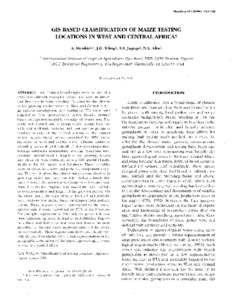| dc.contributor.author | Menkir, A. |
| dc.contributor.author | Kling, J.G. |
| dc.contributor.author | Jagtap, S.S. |
| dc.contributor.author | Aliu, B.A. |
| dc.date.accessioned | 2022-07-28T09:40:12Z |
| dc.date.available | 2022-07-28T09:40:12Z |
| dc.date.issued | 2000 |
| dc.identifier.citation | Menkir, A., Kling, J.G., Jagtap, S.S. & Aliu, B.A. (2000). GIS based classification of maize testing locations in West and Central Africa. Maydica, 45, 143-150. |
| dc.identifier.issn | 0025-6153 |
| dc.identifier.uri | https://hdl.handle.net/20.500.12478/7585 |
| dc.description.abstract | Stratifying a broad target growing area of a crop into different ecological zones has been an important first step in plant breeding. To cater for the diverse maize growing environments in West and Central Africa, germplasm development and testing at IITA have been targeted to four agroecological zones broadly defined based on experiences and knowledge of researchers. This study was carried out to group maize testing locations with similar climatic features, and then use the groups to produce a map of the refined version of the current maize agroecological zones described by IITA maize breeders for west and central Africa. Climatic variables, including seasonal total rainfall, total evapotranspiration, average minimum temperature, average maximum temperature, annual rainfall, length of the growing season and elevation were extracted from a GIS spatial climatic database for 114 maize test locations. These variables were subjected to cluster and principal component analyses. The results show that cluster analysis was effective in grouping maize test locations with similar climatic features into four distinct regions. Grouping of lowland locations into distinct regions was associated with rainfall, evapotranspiration and length of the growing period. On the other hand, the separation of lowland and mid-altitude locations was mainly based on temperatures and elevation. These regions closely correspond to the maize agroecological zones described by IITA maize breeders. For example, region one of this study comprises test locations representing areas defined as mid-altitudes. Regions two, three and four have test locations situated in areas described as the rain forest, moist savanna and dry savanna, respectively. These regions can, therefore, clearly provide defined boundaries with robust representation of the geographic distribution of the maize agroecological zones in west and central Africa. |
| dc.format.extent | 143-150 |
| dc.language.iso | en |
| dc.subject | Maize |
| dc.subject | Germplasm |
| dc.subject | Climatic Zones |
| dc.subject | Environment |
| dc.subject | Geographical Information Systems |
| dc.title | GIS based classification of maize testing locations in West and Central Africa |
| dc.type | Journal Article |
| cg.contributor.crp | Maize |
| cg.contributor.affiliation | International Institute of Tropical Agriculture |
| cg.contributor.affiliation | Biological Engineering, Gainsevil!e |
| cg.coverage.region | Africa |
| cg.coverage.region | West Africa |
| cg.coverage.country | Nigeria |
| cg.coverage.hub | Headquarters and Western Africa Hub |
| cg.researchtheme | Biotech and Plant Breeding |
| cg.identifier.bibtexciteid | MENKIR:2000 |
| cg.isijournal | ISI Journal |
| cg.authorship.types | CGIAR and advanced research institute |
| cg.iitasubject | Agronomy |
| cg.iitasubject | Climate Change |
| cg.iitasubject | Food Security |
| cg.iitasubject | Maize |
| cg.iitasubject | Plant Diseases |
| cg.iitasubject | Plant Ecology |
| cg.journal | Maydica |
| cg.accessibilitystatus | Limited Access |
| cg.reviewstatus | Peer Review |
| cg.usagerightslicense | Copyrighted; all rights reserved |
| cg.targetaudience | Scientists |
| cg.iitaauthor.identifier | Abebe Menkir: 0000-0002-5907-9177 |
| cg.futureupdate.required | No |
| cg.identifier.volume | 45 |

